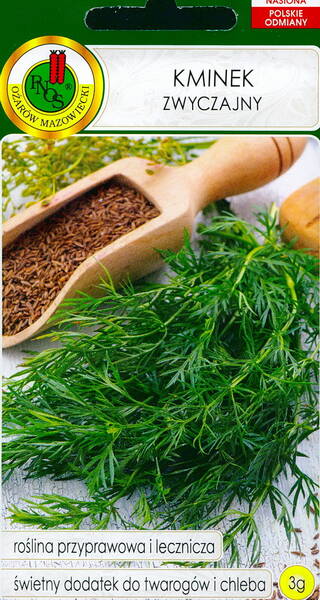A biennial herbaceous plant of the Umbelliferae family, 60-80 cm high. Cold-resistant and medicinal.
Undemanding to heat and soil quality, but develops better in chernozem, sandy loam and light loamy areas.
Seeds are sown to a depth of 2 cm according to the 45 x 20 cm pattern. Blooms in July.
Caraway is sown densely in early spring or before winter to a depth of 2-2.5 cm, then the plants are thinned out, leaving a distance of 10 cm between plants. The seeds germinate slowly, shoots appear only on the 14-22nd day. Sowing rate: 1.0 g/m2.
By the end of the 1st year of life, a basal rosette is formed. In the 2nd year, caraway quickly develops and bears fruit. The fruit is an elongated achene, contains essential oil. Contains mineral salts, ascorbic acid, carotene, rutin. Leaves and young shoots are used in salads, and seeds - for flavoring homemade baked goods, pickling cucumbers, pickling cabbage.
At the stage of stem formation and flowering, it requires sufficient soil moisture.
Crops are kept free of weeds, the row spacing is loosened, and they are fed. In the 1st year, 2 feedings are carried out. The first - on the 20-25th day after emergence (10-15 g of nitrogen and potassium fertilizers per 1 m2). The second feeding before autumn loosening (20 g of phosphorus and 15 g of potassium fertilizers per 1 m2).
Caraway seeds fall off quickly, so you can't be late with harvesting: they are harvested when 70-75% of the seeds turn brown.
1.0 g = 250 seeds.
.jpg)

Caraway. Bot. syn.: Carum velenovskyi Rohlena.
* The most ancient of spices.
This crop has been known to man since ancient times. The fruits of common caraway were found during archaeological excavations in pile buildings dating back to the third millennium BC.
In Asia, caraway was also grown before our era. Dioscorides recommended caraway as a stomach remedy, and in the Middle Ages it was customary to finish a meal by serving caraway sweets. Caraway fruits contain essential oil, steroids, coumarins, flavonoids, fatty acids, tannins, wax, resins and mineral salts.
Caraway is used as a seasoning for cheeses, sausages, bakery products, various fatty dishes and for pickling cabbage. Caraway has gained great popularity as a medicinal plant.
Caraway oil is used in medicine to flavour drugs and as a medicine.
The seeds are included in many herbal mixtures: laxatives, sedatives and appetite stimulants.
Caraway is used for ulcers and stomach upset, atonic, sluggish constipation and excessive fermentation in the intestines, against flatulence. It has a choleretic property. Caraway is useful for nursing mothers, as it stimulates milk production.












